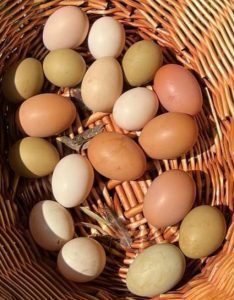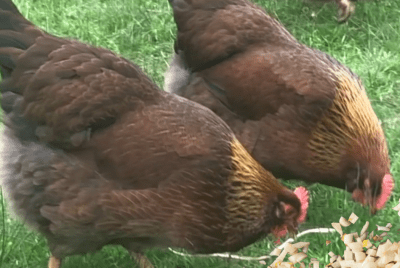Why Do Chickens Stop Laying Eggs?
Introduction: Why Do Chickens Stop Laying Eggs?
As someone deeply passionate about keeping chickens, I often encounter fellow enthusiasts puzzled by the sudden drop in their chickens’ egg production. Don’t forget, we domesticated them and now it is up to us to provide what they need. Why do chickens stop laying eggs: involves delving into various aspects of their health, diet, environment, and even psychological well-being. From my experience, the reasons can range from natural lifecycle changes to more complex health or environmental issues. In this comprehensive guide, we’ll explore these factors in detail, offering practical advice to help you ensure your chickens are not only healthy but also productive in their egg-laying.

Common Factors Affecting Egg Laying
Understanding Age-Related Changes in Why Chickens Stop Laying Eggs Sometimes?
As a chicken enthusiast, I’ve observed firsthand how a hen’s age significantly impacts her egg-laying capacity. Chickens typically begin their egg-laying journey around 6 months old, entering their most productive phase. This period, often termed the ‘golden phase,’ can last until they are about 2 to 3 years old. During this time, it’s not unusual for a healthy hen to lay an egg almost every day, depending on the breed.
However, as chickens age, their egg production naturally begins to decline. This change is gradual and is part of the normal aging process. By the time they reach 3 to 4 years of age, you might notice a noticeable decrease in the number of eggs laid. The eggs they do produce may be larger and occasionally have irregular shapes or shell textures.
The decline in egg production is attributed to the finite number of ova a hen is born with. As they age, the supply diminishes, leading to less frequent egg-laying. Additionally, older hens might take longer breaks between laying eggs and are more likely to experience issues like broodiness.
It’s essential for chicken keepers to understand and anticipate this natural decline. While older hens may not be as prolific in egg production, they still play a valuable role in the flock dynamics and can contribute to a healthy, diverse backyard coop.
The Impact of Nutritional Imbalances answering: Why Do My Chickens Stop Laying Eggs?
Nutrition is a cornerstone of healthy egg production in chickens, and imbalances can lead to significant issues. As a seasoned chicken keeper, I’ve learned that a hen’s diet directly influences not just the quantity, but also the quality of her eggs.
Protein is pivotal in a laying hen’s diet, with a deficiency often resulting in a reduced number of eggs. Hens require a higher protein intake to support the egg formation process. A lack in protein can also lead to smaller eggs and weaker eggshells. Commercial laying feeds are formulated to meet these protein needs, but if hens are overly reliant on lower-protein scraps or forage, their egg production can suffer.
Calcium is another critical nutrient for egg-laying hens. It’s essential for strong eggshell formation. A calcium deficiency can lead to thin-shelled or shell-less eggs, making them vulnerable to breakage. It can also negatively impact the hen’s own bone health. Supplementing their diet with oyster shell or eggshell can help prevent calcium deficiencies.
Vitamins, particularly A, D, and E, and minerals like phosphorus, are also vital. Vitamin deficiencies can lead to various health issues, including a decrease in egg production. Ensuring that the chickens have access to a balanced, nutrient-rich diet is key to maintaining their health and egg-laying capabilities.
Understanding and addressing these nutritional requirements can significantly enhance the well-being and productivity of egg-laying hens.
Shedding Light on Why Do Chickens Stop Laying Eggs In the Winter?
The Crucial Role of Daylight in Chicken Laying Patterns

In my journey as a chicken keeper, I’ve discovered that light, specifically the length of daylight, plays a pivotal role in influencing the laying patterns of chickens. Chickens are naturally responsive to the photoperiod – the amount of daylight in 24 hours – which significantly affects their reproductive system.
Hens typically require about 14-16 hours of daylight to maintain optimal egg production. This light stimulates the pituitary gland, which in turn triggers the ovaries to release eggs. In natural conditions, egg production often decreases during the shorter days of autumn and winter, when there are fewer daylight hours. This seasonal change is a chicken’s natural response to the environment, ensuring that they don’t expend energy on egg-laying during harsher conditions when their survival might be at risk.
However, in a controlled environment, such as a backyard coop, supplemental lighting can be used to mimic longer daylight hours. Adding a few hours of artificial light in the morning or evening can help maintain consistent egg production throughout the year. It’s important to note that the light should be increased gradually to avoid stressing the chickens. Also, young chickens should not be exposed to extended lighting too early, as it can lead to premature egg-laying and related health issues.
Balancing natural and artificial light for your chickens can therefore ensure a steady supply of eggs while also respecting the natural rhythms of your birds.
The Natural Rhythm of Egg Laying: Embracing the Seasonal Patterns of Chickens
As a seasoned chicken keeper who values the natural rhythms of my flock, I’ve always been fascinated by how daylight influences their laying patterns. Unlike many, I choose not to use artificial lighting in my coop. My philosophy is centered around allowing hens to follow their natural laying cycle, which I believe is crucial for their health and longevity.
Chickens are instinctively tuned to daylight. Typically, hens need about 14-16 hours of daylight for peak egg production. As the days shorten in autumn and winter, their egg-laying naturally decreases. This seasonal rest period is important; it allows hens to recover and rejuvenate. During these shorter days, their bodies conserve energy and resources, necessary for enduring the colder months.
To accommodate this natural cycle and ensure a consistent egg supply, I keep a few more hens than I need. This strategy results in a surplus of eggs during the longer, sunnier days of spring and summer. It’s a delightful time when the coop is bustling with activity, and the hens are at their most productive.
To preserve the excess eggs:
I employ a traditional method known as egg glassing or water glassing. This remarkable technique involves submerging fresh eggs in a solution of hydrated lime and water, which can keep them preserved for up to two years. It’s a simple yet effective way to store surplus eggs without refrigeration, ensuring we have a steady supply even when the hens are on their natural laying break.
This approach to chicken keeping, focused on respecting the natural laying patterns of chickens, has been rewarding. It allows my hens to live more stress-free lives, aligning with the natural ebb and flow of their laying cycles, and provides my family with a year-round supply of eggs. Embracing this method reflects a commitment to sustainable and humane poultry keeping, honoring the natural processes of these remarkable birds.
Health Issues That Can Hinder Egg Production

Tackling Parasitic Infections in Chickens: A Key to Maintaining Egg Production
In my years of caring for chickens, I’ve learned that parasitic infections are not just a health hazard but also a significant hindrance to egg production. Understanding and managing these infections is crucial for the health of the flock and consistency in egg laying.
Parasites, both internal and external, can affect chickens in various ways. Internal parasites, such as roundworms, tapeworms, and coccidia, can cause significant damage to a chicken’s digestive system. This impact on their ability to absorb nutrients directly affects their egg production. Infected hens may produce fewer eggs, and those eggs might be of lower quality. Symptoms of internal parasitic infections include weight loss, diarrhea, and a drop in egg production.
External parasites like mites and lice are equally detrimental. They feed on the chicken’s blood, causing anemia, decreased immunity, and overall stress. This not only affects the health of the chicken but can lead to a reduction in egg laying. Chickens infested with mites might spend more time preening and less time on egg-laying activities.
Regular deworming, maintaining cleanliness in the coop, and monitoring the flock for signs of infestation are essential practices. Addressing parasitic infections promptly ensures the chickens remain healthy and productive, maintaining a steady supply of eggs. As a chicken keeper, staying vigilant against these parasites is a constant but necessary task to ensure the wellbeing of the flock.
Common Diseases in Chickens Affecting Optimal Egg Production.
I’ve encountered several diseases that can significantly impact egg laying. Understanding these diseases is crucial for maintaining the health and productivity of the flock. Infectious Bronchitis: This viral respiratory infection is one of the most common diseases affecting egg-laying hens. It’s highly contagious and can spread rapidly through a flock. Symptoms include coughing, sneezing, and nasal discharge. In laying hens, the disease can cause a sharp drop in egg production, and eggs that are laid often have wrinkled shells and poor quality.
Egg Drop Syndrome (EDS): EDS is a viral infection that results in a sudden decline in egg production. Affected eggs may have thin shells and abnormal shapes. The disease primarily affects hens in their peak laying period and can spread through contaminated equipment or direct contact.
Fowl Pox: Transmitted by mosquitoes, Fowl Pox is a slow-spreading viral disease. It presents in two forms: dry pox, which causes wart-like lesions on unfeathered skin, and wet pox, affecting the respiratory tract. Both forms can stress the birds, leading to decreased egg production.
Avian Influenza: Commonly known as bird flu, Avian Influenza can affect egg production severely. Symptoms range from reduced appetite and egg production to respiratory distress. In severe cases, it can be fatal.
Preventing these diseases involves maintaining strict biosecurity, vaccinating where possible, and ensuring good nutrition and housing conditions. Regular health checks and prompt veterinary care at the first sign of illness are key to managing these diseases and keeping your flock laying effectively.
Environmental And Psychological Factors

The Role of Stress and Environment on Chicken Egg Production
In my journey of raising chickens, I’ve learned that the environment and psychological well-being of hens play a crucial role in their egg-laying capacity. A stress-free and comfortable environment is as important as nutrition and health management for optimal egg production.
Stress Factors: Various stressors can affect chickens, leading to a decrease in egg laying. Predators, loud noises, extreme weather conditions, or even changes in the flock dynamic can cause stress. Chickens are particularly sensitive to disruptions in their routine, which can result in a temporary pause in egg laying. It’s vital to minimize these stressors by providing a secure, peaceful, and stable environment.
Environmental Conditions: The condition of the coop and surrounding area significantly impacts a hen’s ability to lay eggs. Overcrowding can lead to stress and aggressive behavior, while inadequate shelter from the elements can cause discomfort and health issues. The coop should be spacious, well-ventilated, clean, and safe from predators. Additionally, providing a natural setting with opportunities for foraging and dust bathing can greatly enhance their quality of life.
Temperature and Lighting: Chickens need a balanced amount of light and comfortable temperatures to maintain regular egg production. Extreme temperatures, either hot or cold, can stress the birds and affect their laying patterns. Ensuring adequate shade in summer and warmth in winter is crucial.
By addressing these environmental and psychological factors, we can create an atmosphere that not only supports the health of our chickens but also encourages consistent egg laying. A happy and stress-free chicken is more likely to be a productive layer.
The Detrimental Effects of Overcrowding on Chicken Health and Why Do Chickens Stop Laying Eggs all of A Sudden?
One of the critical factors influencing the health and productivity of my flock is the living space they are provided. Overcrowding in the coop and run can lead to numerous issues, significantly impacting the well-being of the chickens and why chickens stop laying eggs.
Physical Health Risks: Overcrowding can lead to heightened competition for food, water, and nesting space, often resulting in weaker or lower-ranking chickens being malnourished. This stress on physical health directly affects egg production. Furthermore, cramped conditions are a breeding ground for diseases and parasites, which can spread rapidly among the flock.
Behavioral Issues: Chickens in overcrowded conditions often exhibit increased aggression. Pecking order disputes become more frequent and intense, leading to stress and injuries. Stressed chickens are known to lay fewer eggs, and the eggs they do lay can be of poorer quality.
Reduced Immunity: Stress from overcrowding weakens the immune system of chickens, making them more susceptible to illnesses, which can further reduce their egg-laying capability.
Environmental Stress: Lack of sufficient space can also inhibit natural behaviors such as foraging, dust bathing, and wing stretching, essential for the physical and psychological well-being of chickens.
To ensure optimal egg production and a healthy flock, it’s crucial to provide adequate space. As a rule of thumb, each chicken should have at least 3-4 square feet of coop space and 8-10 square feet in the run. Adhering to these space requirements helps in reducing stress, preventing disease, and promoting natural behaviors, all contributing to a healthy, productive flock.

Breed Specific Traits and Egg Laying
Appreciating the Diversity: Egg-Laying Traits Across Different Chicken Breeds
The breed of chicken plays a pivotal role in egg-laying characteristics. Each breed comes with its unique traits, influencing not only the quantity of eggs laid but also their size, color, and even the hen’s laying habits.
High-Production Breeds: Breeds like the Leghorn, Rhode Island Red, and Sussex are known for their high egg production. Leghorns, for example, can lay up to 280 eggs per year, producing large, white eggs. Rhode Island Reds are hardy and consistently lay large, brown eggs.
Heritage Breeds: While not as prolific as high-production breeds, heritage breeds like the Plymouth Rock or the Wyandotte offer other benefits. They tend to be more robust and have longer lifespans, laying eggs over a more extended period.
Bantam Breeds: Bantams, like the Silkie or Sebright, are smaller and lay smaller eggs less frequently. However, they are often kept for their ornamental value and friendly nature.
Egg Color Variations: Some breeds are sought after for their unique egg colors. Araucanas and Ameraucanas, for example, lay beautiful blue and green eggs, while Marans produce rich chocolate brown eggs.
Understanding these breed-specific traits is crucial for chicken enthusiasts to align their expectations with the reality of their flock. Whether seeking maximum egg production or a colorful egg basket, choosing the right breed to match your goals is a key aspect of successful chicken keeping.
You might also find these articles helpful:




















